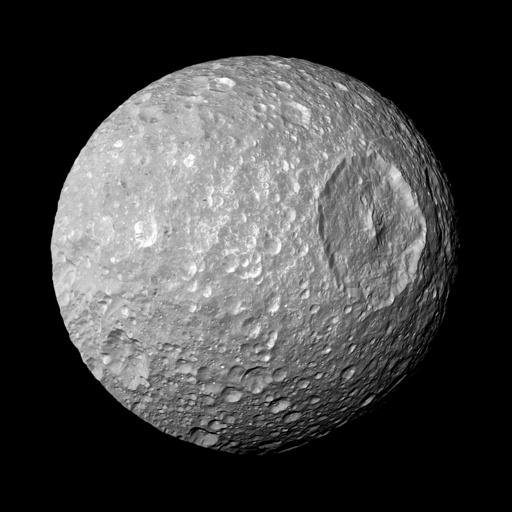Saturn’s Death Star-looking moon may have vast underground ocean

This Feb. 13, 2010 image provided by NASA shows Saturn’s moon Mimas and it’s large Herschel Crater, captured by the Cassini spacecraft. The crater is 130 kilometers (80 miles) wide. Astronomers have reported the best evidence yet of a vast, relatively new ocean beneath the icy exterior of Mimas, believed between 5 million and 15 million years old. The findings were published Wednesday, Feb. 7, 2024, in the journal Nature. (NASA/JPL-Caltech/Space Science Institute via AP)
CAPE CANAVERAL, Florida — Astronomers have found the best evidence yet of a vast, young ocean beneath the icy exterior of Saturn’s Death Star lookalike mini moon.
The French-led team analyzed changes in Mimas’ orbit and rotation and reported Wednesday that a hidden ocean 12 to 18 miles (20 to 30 kilometers) beneath the frozen crust was more likely than an elongated rocky core. The scientists based their findings on observations by NASA’s Cassini spacecraft, which observed Saturn and its more than 140 moons for more than a decade before diving through the ringed planet’s atmosphere in 2017 and burning up.
Barely 250 miles (400 kilometers) in diameter, the heavily cratered moon lacks the fractures and geysers — typical signs of subsurface activity — of Saturn’s Enceladus and Jupiter’s Europa.
READ: One of Saturn’s moons has a key building block of life
“Mimas was probably the most unlikely place to look for a global ocean — and liquid water more generally,” co-author Valery Lainey of the Paris Observatory said in an email. “So that looks like a potential habitable world. But nobody knows how much time is needed for life to arise.”
Article continues after this advertisementResults were published in the journal Nature.
Article continues after this advertisementThe ocean is believed to fill half of Mimas’ volume, according to Lainey. Yet it represents only 1.2% to 1.4% of Earth’s oceans given the moon’s petite size. Despite being so small, Mimas boasts the second largest impact crater of any moon in the solar system — the reason it’s compared to the fictional Death Star space station in “Star Wars.”
READ: Saturn’s icy moon Enceladus harbors essential elements for life
“The idea that relatively small, icy moons can harbor young oceans is inspiring,” SETI Institute’s Matija Cuk and Southwest Research Institute’s Alyssa Rose Rhoden wrote in an accompanying editorial. They were not part of the study.
Believed between 5 million and 15 million years old, too young to mark the moon’s surface, this subterranean ocean would have an overall temperature right around freezing, according to Lainey. But at the seafloor, he said the water temperature could be much warmer.
Co-author Nick Cooper of Queen Mary University of London said the existence of a “remarkably young” ocean of liquid water makes Mimas a prime candidate for studying the origin of life.
Discovered in 1789 by English astronomer William Herschel, Mimas is named after a giant in Greek mythology.